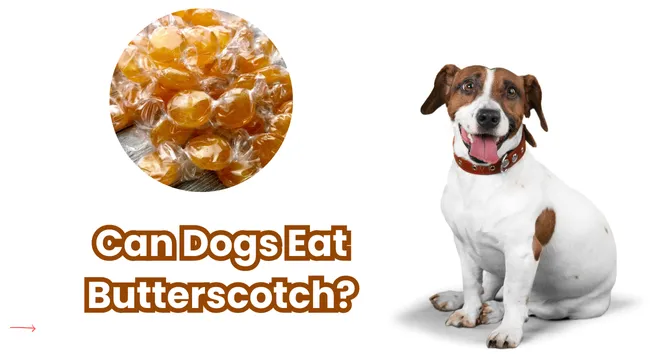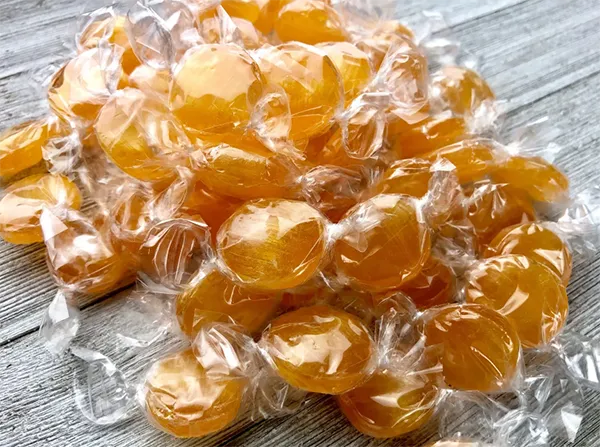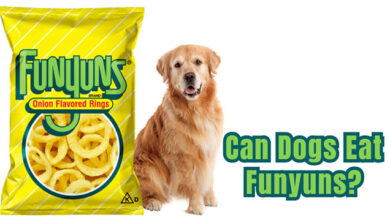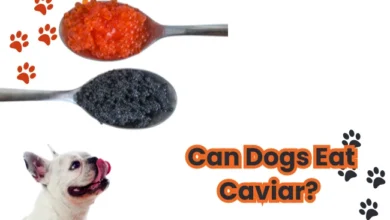
We all love treating our dogs to special snacks, but it’s important to know which human foods are safe for them. One treat that often raises eyebrows is butterscotch. Butterscotch, with its rich, sweet flavor, is a favorite among many people, but can dogs eat butterscotch?
This sweet confection is made primarily from brown sugar and butter, sometimes mixed with ingredients like corn syrup, cream, vanilla, and salt. Originating in mid-19th century Yorkshire, butterscotch was initially made with treacle (molasses). While it’s a delicious treat for humans, it’s crucial to understand its effects on our canine companions.
In this article, we will dive into the ingredients of butterscotch, discuss whether dogs can safely consume it, and explore healthier alternatives for your furry friend. Whether you’re a new dog owner or a seasoned pet parent, it’s essential to stay informed about what foods are best for your dog’s health and happiness.
Can Dogs Eat Butterscotch?
Dogs should not eat butterscotch. While the primary ingredients—brown sugar and butter—are not toxic to dogs in small amounts, they are not healthy for them either. Butterscotch often contains high amounts of sugar and fat, which can lead to obesity, dental problems, and pancreatitis in dogs.
Additionally, some recipes for butterscotch may include ingredients like corn syrup and vanilla, which can cause further health issues. In particular, artificial sweeteners like xylitol, sometimes used in confectioneries, are highly toxic to dogs.
It’s always best to avoid giving your dog any sweets or human treats and stick to dog-friendly snacks and treats. If you suspect your dog has eaten a large amount of butterscotch, it’s a good idea to consult your veterinarian for advice.
Read More: Can Dogs Eat Banana Peppers?
What is Butterscotch?

Definition and History
Butterscotch is a type of confectionery known for its rich, sweet flavor, primarily made from brown sugar and butter. The mixture is heated until it reaches a specific consistency and flavor profile, resulting in a smooth, caramel-like treat. The name “butterscotch” is believed to have originated in mid-19th century Yorkshire, England, where the earliest known recipes were created. Traditionally, butterscotch was made with treacle (molasses) in addition to or instead of sugar, giving it a distinct, deep flavor.
Common Ingredients
The core ingredients of butterscotch are:
- Brown Sugar: Provides the characteristic sweetness and caramel-like flavor.
- Butter: Adds richness and a creamy texture to the confection.
Additional ingredients that are often used in butterscotch recipes include:
- Corn Syrup: Used to prevent crystallization and enhance the smooth texture.
- Cream: Adds extra richness and a softer texture.
- Vanilla: Provides a subtle, aromatic flavor that complements the sweetness.
- Salt: Enhances the overall flavor by balancing the sweetness and adding depth.
Variations in Recipes
Butterscotch recipes can vary widely, with different ingredients and preparation methods leading to slight changes in flavor and texture. Some common variations include:
- Traditional Butterscotch: Made with treacle (molasses) for a deeper, more complex flavor.
- Soft Butterscotch Candies: Often include cream and corn syrup to achieve a softer, more chewy texture.
- Butterscotch Sauce: A thinner, pourable version used as a topping for desserts like ice cream or pancakes.
- Butterscotch Pudding: A creamy, custard-like dessert made by incorporating eggs and cornstarch into the basic butterscotch mixture.
Each variation brings a unique twist to the classic butterscotch flavor, making it a versatile treat enjoyed in many forms.
Read More: Can Dogs Eat Tamales?
Nutritional Content of Butterscotch
Breakdown of Ingredients
- Brown Sugar: Brown sugar is the primary sweetener in butterscotch, giving it its signature caramel flavor. It is high in simple carbohydrates and contributes a significant amount of sugar to the treat.
- Butter: Butter adds richness and a creamy texture to butterscotch. It is high in saturated fats, which can contribute to high calorie content.
- Corn Syrup: Corn syrup is often used to prevent crystallization and keep butterscotch smooth. It is another source of simple sugars and adds to the overall sugar content.
- Cream: Cream is used to enrich the texture and flavor. It is high in both fat and calories, contributing to the treat’s rich taste.
- Vanilla: Vanilla is typically used in small amounts to add flavor. It does not significantly affect the nutritional content but enhances the overall taste.
- Salt: A small amount of salt is added to balance the sweetness and enhance the flavors. While minimal, it adds a slight sodium content to the treat.
Caloric Content and Macronutrient Composition
Butterscotch is high in calories due to its combination of sugars and fats. A typical serving contains:
- Calories: A small piece can have upwards of 50-100 calories.
- Carbohydrates: Predominantly from sugar, contributing to a high glycemic index.
- Fats: Mostly from butter and cream, high in saturated fats.
- Protein: Minimal, as butterscotch is not a significant source of protein.
Read More: Can Dogs Eat Yellow Rice?
Potential Risks of Butterscotch for Dogs
High Sugar Content
Effects on Dog’s Health:
- Obesity: Excessive sugar intake can lead to weight gain and obesity, which can strain a dog’s joints and lead to other health issues.
- Diabetes: High sugar consumption increases the risk of developing diabetes in dogs, affecting their insulin regulation.
- Dental Issues: Sugar contributes to dental problems like cavities and gum disease, which can be painful and costly to treat.
High Fat Content
Potential for Pancreatitis:
- Pancreatitis: The high fat content in butter and cream can cause inflammation of the pancreas, leading to pancreatitis. This condition can be very painful and dangerous for dogs, requiring immediate veterinary care.
Artificial Ingredients and Additives
Dangers of Xylitol and Other Artificial Sweeteners:
- Xylitol: This artificial sweetener is highly toxic to dogs, even in small amounts. It can cause a rapid release of insulin, leading to hypoglycemia (low blood sugar), seizures, liver failure, and even death.
- Other Additives: Artificial flavors and preservatives can also pose health risks, leading to allergic reactions or gastrointestinal upset.
Overall, while butterscotch is a delightful treat for humans, it poses several health risks for dogs. It’s important to avoid giving butterscotch to your canine companions and instead opt for treats specifically designed for their dietary needs.
Read More: Can Dogs Eat Egg Rolls?
Specific Ingredients in Butterscotch and Their Effects on Dogs
Sugar and Brown Sugar
Impact on Blood Sugar Levels:
- Blood Sugar Spikes: Both regular sugar and brown sugar can cause rapid spikes in a dog’s blood sugar levels. Unlike humans, dogs do not metabolize sugar as efficiently, leading to potential health issues.
- Diabetes Risk: Consistently high sugar intake can increase the risk of diabetes in dogs, which affects their ability to regulate insulin and maintain healthy blood glucose levels.
Butter and Cream
High Fat Content and Potential Digestive Issues:
- High Fat Content: Butter and cream are rich in fats, particularly saturated fats. High-fat foods can lead to obesity, which strains a dog’s joints and overall health.
- Digestive Issues: Dogs are not well-equipped to handle large amounts of dairy fat, leading to gastrointestinal issues like diarrhea, vomiting, and discomfort. Additionally, some dogs are lactose intolerant, which can exacerbate these symptoms.
Corn Syrup
Additional Sugar and Potential for Weight Gain:
- Extra Sugar: Corn syrup adds even more sugar to butterscotch, compounding the risks associated with sugar consumption. This can lead to blood sugar spikes, energy crashes, and long-term health problems.
- Weight Gain: The high caloric content from corn syrup can contribute to unhealthy weight gain. Obesity in dogs can lead to numerous health issues, including heart disease, joint problems, and decreased lifespan.
Vanilla and Salt
Safe in Small Amounts but Can Be Harmful in Large Quantities:
- Vanilla: In small amounts, vanilla is generally safe for dogs. However, some vanilla extracts contain alcohol, which is toxic to dogs. Large quantities of vanilla can also cause gastrointestinal upset.
- Salt: While dogs need some salt in their diet, too much can be harmful. Excessive salt intake can lead to sodium ion poisoning, which causes symptoms like vomiting, diarrhea, tremors, elevated body temperature, and seizures.
Read More: Can Dogs Eat Orange Chicken?
Symptoms of Butterscotch Toxicity in Dogs
Signs to Watch For
Vomiting: One of the first signs of butterscotch toxicity is vomiting. This is the body’s way of trying to expel the harmful substance.
Diarrhea: Consuming high sugar and fat content can upset a dog’s digestive system, leading to diarrhea. Persistent diarrhea can cause dehydration and other complications.
Lethargy: Dogs that have ingested butterscotch may become unusually tired or sluggish. This could be due to a spike in blood sugar levels followed by a crash, or overall discomfort.
Abdominal Pain: Dogs may show signs of abdominal pain such as whining, restlessness, or a hunched posture. This is often due to the rich, fatty content of butterscotch irritating their digestive system.
Changes in Behavior: You might notice changes in your dog’s behavior, such as irritability, confusion, or excessive drooling. These can be signs of a more serious reaction to the butterscotch ingredients.
Long-term Health Consequences
- Obesity: Regular consumption of high-calorie, sugary foods like butterscotch can lead to obesity. This, in turn, can cause joint problems, decreased mobility, and a reduced quality of life.
- Diabetes: High sugar intake increases the risk of diabetes in dogs, leading to chronic health issues that require ongoing management and treatment.
- Pancreatitis: The high fat content in butterscotch can cause pancreatitis, an inflammation of the pancreas that can be very painful and potentially life-threatening.
- Dental Issues: Sugar contributes to tooth decay and gum disease, leading to dental problems that can cause pain and affect a dog’s ability to eat.
Read More: Can Dogs Eat Babybel Cheese?
What to Do If Your Dog Eats Butterscotch
Immediate Steps to Take
- Assess the Situation: Determine how much butterscotch your dog has consumed and try to identify any additional harmful ingredients (e.g., xylitol).
- Remove Access: Ensure your dog can’t eat any more of the butterscotch or other potentially harmful foods.
- Observe Your Dog: Watch for any signs of distress or symptoms of toxicity such as vomiting, diarrhea, lethargy, or behavioral changes.
When to Contact a Veterinarian
- Immediate Contact: If your dog shows any symptoms of toxicity or if you suspect they have consumed a large amount of butterscotch, contact your veterinarian immediately.
- Precautionary Call: Even if your dog seems fine, it’s a good idea to call your vet for advice. They can provide guidance on what steps to take and whether your dog needs to be seen.
Possible Treatments and Interventions
- Inducing Vomiting: In some cases, your veterinarian may recommend inducing vomiting to expel the butterscotch from your dog’s system.
- Activated Charcoal: This may be administered to help absorb any remaining toxins in the stomach.
- IV Fluids: If your dog is dehydrated from vomiting or diarrhea, IV fluids may be necessary to rehydrate and balance electrolytes.
- Medication: Your vet may prescribe medications to manage symptoms such as nausea, pain, or inflammation.
- Monitoring: In severe cases, your dog may need to be monitored at the veterinary clinic to ensure they recover without complications.
By understanding the symptoms of butterscotch toxicity and knowing what steps to take, you can help ensure your dog stays safe and healthy. Always consult your veterinarian when in doubt about your pet’s health.
Read More: Can Dogs Eat Tuna?
Preventing Accidental Consumption
Keeping Butterscotch and Other Sweets Out of Reach
One of the simplest and most effective ways to prevent your dog from eating butterscotch is to keep it, and other sweets, out of their reach. Store treats on high shelves or in cabinets where your dog cannot access them. Be mindful of places where dogs can easily jump or climb to reach food, such as kitchen counters and tables.
Educating Family and Friends About the Risks
Make sure everyone in your household, including guests, is aware that butterscotch and similar sweets are not safe for dogs. Educate them on the potential health risks and the importance of keeping such treats away from your pet. This awareness can help prevent accidental feeding and ensure everyone is vigilant about your dog’s diet.
Using Secure Storage for Human Treats
Invest in secure storage containers with tight-fitting lids to keep butterscotch and other human treats safely stored away. This not only prevents your dog from accessing them but also helps keep the treats fresh. Consider using child-proof locks on cabinets or drawers that contain foods harmful to dogs.
Read More: Can Dogs Eat Acai?
Conclusion
In conclusion, while butterscotch may be a delightful treat for humans, it poses several health risks for dogs. The high sugar and fat content can lead to obesity, diabetes, pancreatitis, and dental issues, while certain artificial sweeteners like xylitol are highly toxic to dogs. It is essential to keep butterscotch and other sweets out of your dog’s reach and educate family and friends about these dangers. Using secure storage for human treats can also help prevent accidental consumption. Prioritizing a proper diet and nutrition is crucial for your dog’s health and well-being, ensuring they remain happy and active. Always consult with your veterinarian if you suspect your dog has consumed something harmful. By taking these preventive measures, you can keep your furry friend safe and healthy. Remember, when it comes to butterscotch and dogs, it’s best to err on the side of caution.



